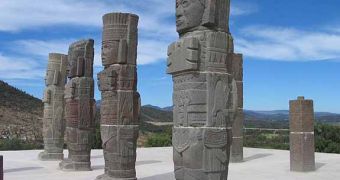Aztecs, Mayas and their preceding civilizations in Central America are famous for their appetite for blood.
The cruel and megalomaniac sacrifice rites produce stupor amongst modern people and these people knew very well how to use it against their enemies.
Would you have opposed them when you were risking to be sacrificed by ripping off your heart from your chest while still alive?
A new discovery adds another gruesome aspect to the picture. Archaeologists have found the remains of 24 children who must have been sacrificed in the honor of the rain god a millennium ago. "The bones of the children, dating from about 950 to 1150, were found on the outskirts of the Toltec archaeological zone of Tula," said Luis Gamboa, an archaeologist with the National Institute of Anthropology and History.
The site is located roughly 40 miles (65 km) north of Mexico City.
The Toltecs predated the Aztecs, the civilization that Spanish conquistadors faced in central Mexico in the 16th century, for a couple of centuries, from 10th to 12th centuries.
They dominated the area before the rise of the Aztecs, and many believe they were related to them or at least spoke a similar language.
The children were 5 to about 15 years old and were discovered in just one pit during the excavations that began in March just outside the archaeological site.
The bodies were facing east, around a shrine to the god Tlaloc. "This was something collective, done simultaneously. They had some incisions on the vertebrae that suggested they had used some sort of stone to cut their throats," Gamboa said.
Spanish recordings written soon after the conquest of the Aztecs by Spain in 1521 acknowledged that they sacrificed children and Aztec children sacrifices sites offered to the rain god had been found. "The Aztecs believed that sacrificed children would become the servants of Tlaloc, and bring more rain," said Archaeologist Victor Arribalzaga, who is digging at a Tlaloc temple on the eastern outskirts of Mexico City.

 14 DAY TRIAL //
14 DAY TRIAL //